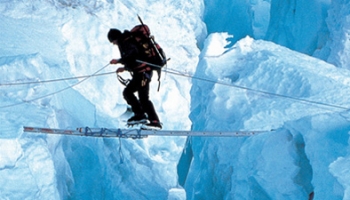
Climber returns to highest mountain to bury the stranger he was forced to leave behind at 28,000ft nine years ago.

The following article was written by Paul Harris
and appeared May 1, 2007 in the Daily Mail.
She was alone on the mountain shelf when the climbers found her - a frozen pathetic figure just 800ft below the summit of Everest. Francys Arsentiev barely had the strength left to speak - but her last words would stay with them for the rest of their lives.
'Don't leave me,' she begged. 'Please don't leave me.' In the treacherous terrain of the world's highest mountain, and in temperature of -30C, they had little choice. They stayed with her for as long as they could before abandoning their summit attempt and heading back down for help. In their hearts, however, they knew they were leaving her to die.
By the time another climbing party got to her, Fran had already succumbed to the cold. No-one could help her now. It was too dangerous even to contemplate carrying her body down the North Face from its precarious position on the loose rock shards that formed the steep mountain shelf. For the next nine years, the 40 year old American would remain a macabre beacon of death at 28,000ft - clearly visible to the many adventures who would subsequently take the same route to the top.
Even today,the bright purple of her climbing jacket stands out against the snow. She still lies in the same, grotesquely distorted position she was in when the other climbers found her, secured by a rope and largely preserved by the sub-zero temperatures.
Bur now - finally - she is about to be afforded some dignity. The British -born climber who had to abandon the stricken stranger to the elements in May 1998 has gone back to Everest to bury her.
Ian Woodall is leading an expedition to provide a poignant last chapter to a tragedy that continues to haunt the mountain. He will wrap her in an American flag, lay her to rest within sight of the summit she had earlier conquered, and cover her with a cairn of stones and boulders to shield her body from view. They he will speak at her graveside - and bring to a close the promise that he and his climbing partner Cathy O'Dowd made that day to do everything they could for her.
Yesterday from a camp more than 17,000ft up the north side of Everest, the 50-year-old mountaineer told me by satellite telephone:'It's something I felt I wanted to do, not something I felt obliged to do. We went back for the summit a year later and we could see her clearly when we began to come down. I was a little startled unit it dawned on me that the mountain would never really consume her. It would always keep her there like that.
'At the back of my mind, I hoped someone would eventually do something for her. But of course, the only reason anyone would be up that high is if they're on the way up to the summit or on the way down. In either case, you really can't devote the hours and workload required to bury a corpse. 'It needed a dedicated mission by someone like m, who's been to the summit a couple of times already.
'This will probably be my last expedition, so I thought it would be appropriate to give something back.' Fran a mother from Colorado, died after securing a place in the record books as the first American woman to conquer Everest's 29,000ft without supplementary oxygen. She is believed to have collapsed or fallen just below the so-called First Step, some 800ft into her descent, as she climbed down with her Russian husband Serguei Arsentiev. He is assumed to have died trying to get help.
Mr. Woodall and his team came across her as they were attempting to reach the summit. 'We did everything we could fo rher but everyone knew she didn't really stand a chance,' he said. He and Cathy O'Dowd tried for more than an hour to keep Fran conscious and see if they could move her before deciding it was hopeless.
When she slipped into silence they descended towards Base Camp, knowing, in realty, that they could not raise help in time. Mr. Woodall, who has a string of climbing achievements, faced a wave of criticism afterwards for effectively leaving Fran to die. Yesterday, he insisted it would have been impossible to save her, adding: 'You can only do what you're able to do at the time. Unfortunately, in the rish aversion society we live in today, you're not allowed to have accidents. There's always go to be someone to blame.'
Likewise Cathy, who later married Mr. Woodall and wrote a book about her Everest experiences, said: 'Anyone who becomes immobile on a mountain as remote and large as Everest is probably going to die.'
Fran, who had a young son, Paul, is one of three bodies Mr. Woodall is hoping to bury. The others are an Indian who died in a 1996 storm and Briton David Sharp, who died last May on a lone descent.
Completing the burials will be governed by the weather - and whether Mr. Woodall and his two Sherpas have the means and stamina to carry out the operation at such altitude, and in such difficult terrain.
He is chronicling his mission on the Internet at taoofeverest.com and plans to write a book.

